After seeing the addition of partisan data for New York, I decided to try my hand at creating a 28-0 map of New York (well at least a map where Obama won 28 districts in 2008).
From the outset, there are a couple of assumptions that went into the design.
1) Keep intact county lines as much as possible.
2) Make it difficult for Republicans to win the district.
3) Ignore homes of incumbents (both R and D)
4) I also did not match up existing district numbers with the map
The top level description of the map is that I succeeded. In western NY, I grouped counties in an East-West manner, splitting Buffalo and stretching those districts from the Finger Lakes to Lake Erie. In eastern NY, I grouped counties North/South with Scott Murphy's District going from the Canadian border to Dutchess County. On Long Island, I split NY 2 to go East-West across eastern Suffolk and Nassau counties.
In the end, I created 28 districts Obama won, with only four district where Obama won with 51% of the vote or less.
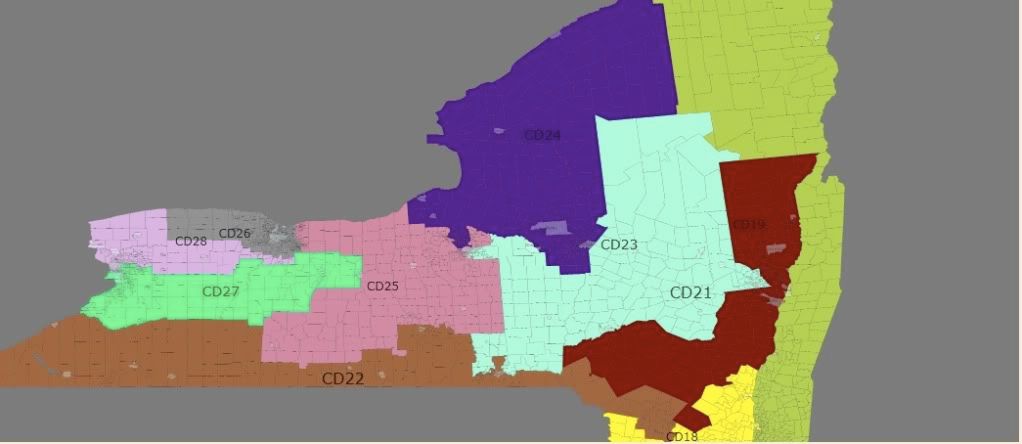
Long Island
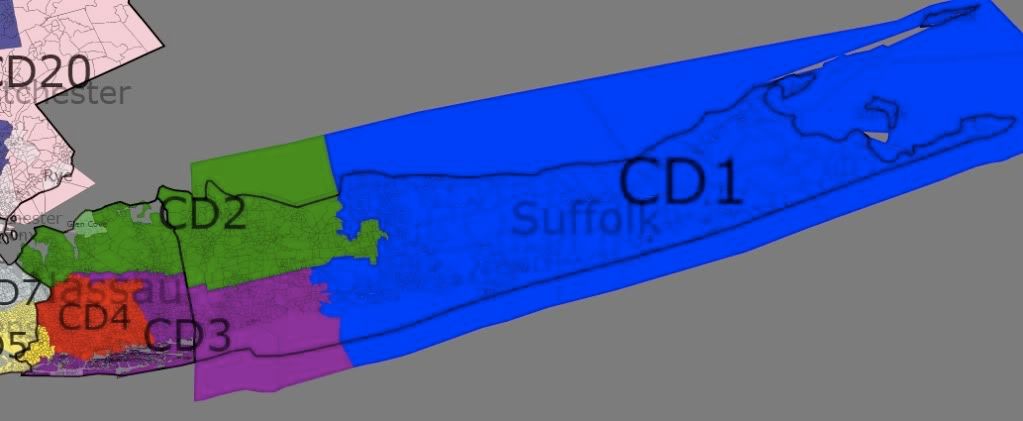
The goal for Long Island was to create three Democratic performing districts in Suffolk and Nassau counties. To that end I was successful, however, there are two or three Districts that in the wrong year, could flip to the Republicans. However, since Democratic performance has been improving in this area, it is possible that demographic trends will preserve Democrats in this area.
CD 1: (blue) Suffolk – 83% White 8% Hispanic
52-47 Obama
CD 2: (green) Suffolk, Northern Nassau – 81% White 8% Hispanic
52-47 Obama
CD 3: (purple) Suffolk, Southern Nassau – 76% White 11% Hispanic
51-47 Obama
CD 4: (red) South and West Nassau – 65% White 15% Black 12% Hispanic
57-42 Obama

I admit I am not familiar with the actual New York City area to make an informed observation about these districts, but I do preserve a number of minority-majority districts. Only the Staten Island district may flip in a bad year.
CD 5: (yellow) South Queens – 22% White 49% Black 14% Hispanic
81-18 Obama
CD 6: Central Brooklyn – 6% White 73% Black 14% Hispanic
95-4 Obama
CD 7: (grey) Northern Queens – 42% White 27% Asian 18% Hispanic
65-33 Obama
CD 8: Northern Queens, Extends into Kings – 29% White 15% Asian 8% Black 43% Hispanic
74-25 Obama
CD 9: Northern Queens Bronx – 8% White 27% Black 5% Asian 56% Hispanic
90-8 Obama
CD 10: (magenta) Western Queens, Western King – 28% White 29% Black 30% Hispanic
87-11 Obama
CD 11: Southern Brooklyn – 57% White 18% Black 10% Asian 10% Hispanic
58-41 Obama
CD 12: Central/ West Manhattan – 70% White 6% Black 8% Asian 12% Hispanic
82-16 Obama
CD 13: Lower Manhattan/Brooklyn – 53% White 6% Black 17% Asian 18% Hispanic
77-21 Obama
CD 14: Staten Island/Brooklyn – 63% White 6% Black 10% Asian 17% Hispanic 51-47 Obama
CD 15: Harlem/East Side – 21% White 27% Black 45% Hispanic
90-8 Obama
CD 16: (green) Bronx/SE Yonkers – 19% White 30% Black 41% Hispanic
85-14 Obama
Rockland, Westchester area
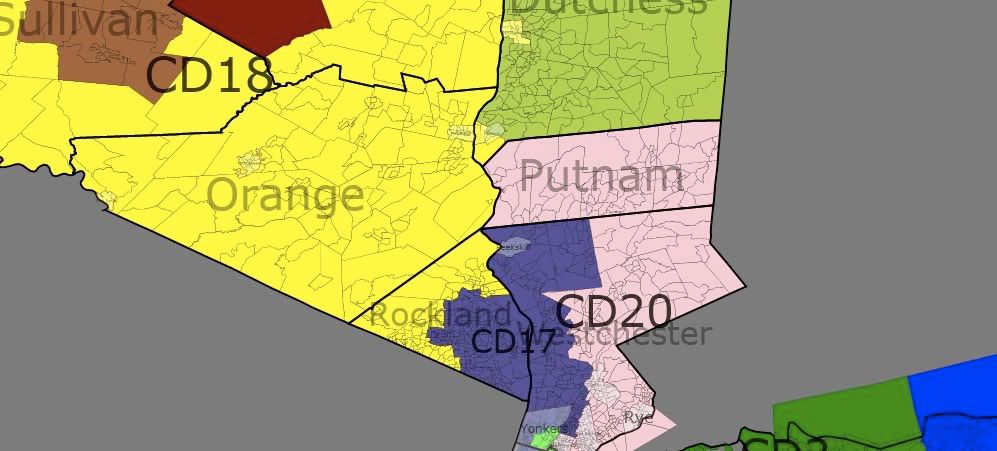
I have three districts extending out of New York City into Yonkers and Rockland and Westchester counties. This arrangement is similar to, but expands upon the current map of the area. where both NY 17 and NY 18 extend into the City.
In the existing eastern most district, NY 18, Representative Lowey has consistently won with over 65% of the vote (Bush/Kerry 58%) – this performance may go down with this map's NY 20. However, this is necessary to strengthen (this map's) NY 18 (Hall), where Obama would have a more comfortable victory.
CD 17: Bronx, W. Westchester, SE Rockland – 64% White 12% Black 15% Hispanic
61-37 Obama
CD 18: (yellow) Orange, S Sullivan, S Ulster, N Rockland, Poughkeepsie – 79% White 7% Black 9% Hispanic
54-44 Obama
CD 20: (pink) Putnam, E Westchester, E Bronx 89% White
53-44 Obama
Upstate NY

Upstate New York keeps counties intact and create nine districts where Democrats should be expected to win in most elections. However, in the right circumstances several districts could flip. However, I expect that no conservative Republican could win in these areas – especially with the trends in New England in support of Democrats.
Unlike the existing map, I took a more radical approach to dividing the districts, weakening the existing District around Albany (Tonko) and around Binghamton (Hinchey). I support Murphy and Owens, as well as take out Lee. However, this map does not respect the residence of incumbents as Owens and Murphy are placed in the same district as well as Maffei and Arcuri.
CD 19: (ugly green) Franklin, Clinton, Essex, Washington, Rensselaer (-Rensselaer), Columbia, Dutchess (most) – 89% White
53-44 Obama
This is Scott Murphy's current district. I help him by extending the district all the way to the Canadian border, and the Democratic leaning counties of Franklin and Clinton counties.
CD 21: (red) Warren, Saratoga, Albany, Greene, Delaware (most), NE. Ulster – 88% White 5% Black
56-42 Obama
I take the Tonko's Albany based district, and go North to Saratoga and then South into Delaware and Ulster counties. The district also includes the City of Rensselaer.
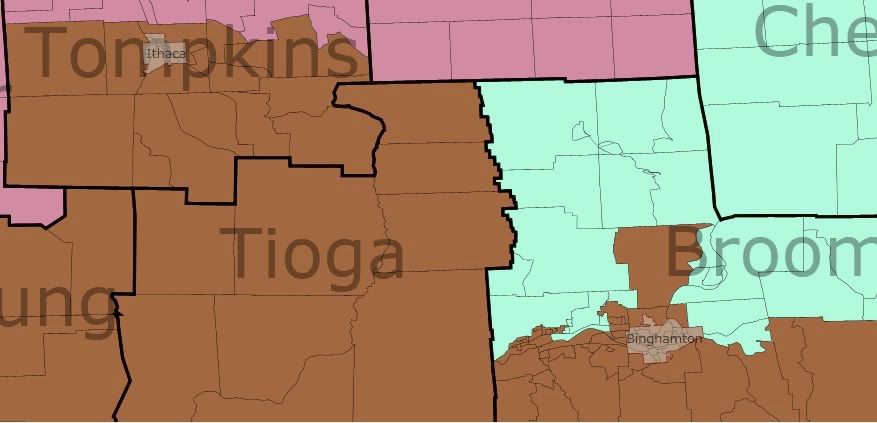
CD 22: (brown) Chautauqua, Cattaragus, Allegany, S. Steuben, Chemung, S. Tompkins, S. Broome, S Delaware, N. Sullivan (includes Binghamton and Ithica) – 89% White
51-46 Obama
Of all the districts that undergo a change, perhaps the most radical change is to Hinchey's district. The district now spans most of New York's southern border, but expands North to take in the city of Ithica. This district is perhaps the toughest to defend in a wave election, but the Democratic strongholds of Ithica and Binghamton should prevent a Republican from staying in office long.
CD 23: (light blue) N. Broome, Chenango, Madison, Ostego, Herkimer, Fulton, Montgonery, Schoharie, Fulton, Hamilton, Onodaga (part) – 90% White
52-46 Obama
This is the district I had the most fun drawing – as it streches across most of Central New York, connecting Syracuse and Schenectady and into the Binghamton suburbs. This is a Democrat performing district, but would vulnerable in a wave election.
CD 24: (purple) St. Lawrence, Jefferson, Lewis, Oneida, Oswego, Onodaga (part) 91% White
50-48 Obama
Because I was not concerend about where incumbents live, I was able to create a Democratic leaning district in Northern New York. The district extends into the Syracuse suburbs to preserve a Democratic lean.
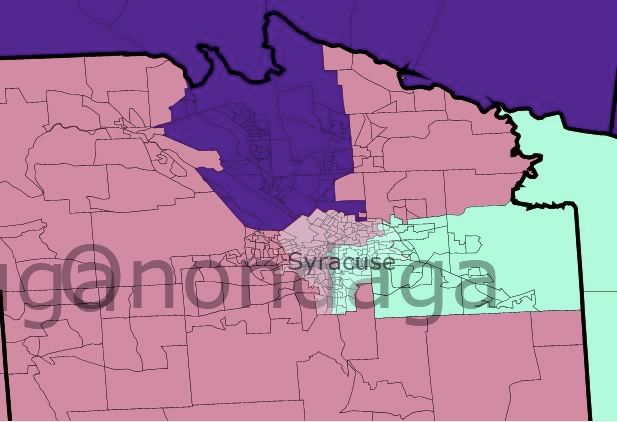
CD 25: Onodaga (Syracuse and S), Wayne, Cayuga, Seneca, Yates, N. Steuben, Schulyer, N. Tompkins, Cortland 90% White
52-46 Obama
With the City of Syracuse divided between the 23rd and 25th, this district expands westward. In a wave election, a Republican could take the district, but turnout in Syracuse should prevent that.
CD 26: (dark grey) Monroe (most), Orleans – 76% White 13% Black 5% Hispanic 58-40 Obama
I make the Rocester area whole -but add in the more conservative Orleans county.

The Buffalo area retains the exsiting split – but both then stretch Eastward to take some of the rural counties in Western NY. Obama still won each of the districts with over 53% of the vote.
CD 27: S and E Erie, Wyoming, Livingston, Ontario – 85% White 10% Black 53-44 Obama
CD 28 – N Erie, Niagara, Genese, S Monroe – 84% White 8% Black 54-43 Obama
In conclusion, a 28-0 vote is possible, but because of the voting patterns in Central and Western NY, a 28-0 map will leave several Democrats vulnerable to a wave election, especially if one goal is compactness and the preservation of county borders.

Loading ...

















